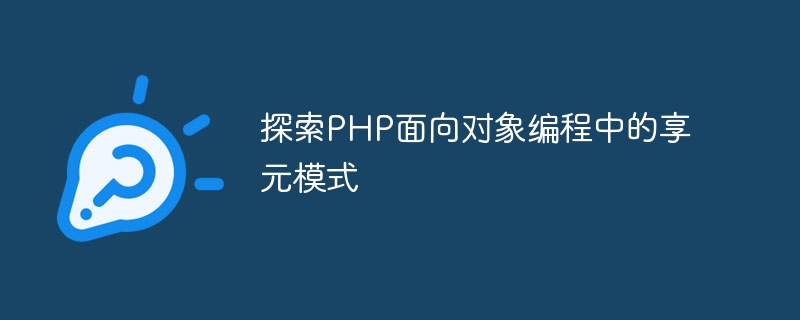Home >Backend Development >PHP Tutorial >Explore the flyweight pattern in PHP object-oriented programming
Explore the flyweight pattern in PHP object-oriented programming
- 王林Original
- 2023-08-10 11:01:19849browse

Exploring the flyweight pattern in PHP object-oriented programming
Introduction:
With the development and complexity of Web applications, object-oriented programming (Object- Oriented programming (OOP) is increasingly used in PHP. The flyweight pattern is a design pattern that optimizes memory consumption in OOP. This article will deeply explore the principles and implementation methods of flyweight mode in PHP, and give code examples.
- What is flyweight mode?
The flyweight pattern is a structural design pattern. Its purpose is to save memory space, reduce the creation and destruction of objects by sharing object instances, and improve program performance. The flyweight pattern is suitable for situations where there are a large number of fine-grained objects, and the internal state of most of the objects can be shared. - How to implement the flyweight mode
In PHP, implementing the flyweight mode requires the following steps:
(1) Create a flyweight factory class
Flyweight factory The class is responsible for managing and creating flyweight objects. It maintains an object pool to store created flyweight objects and reduces memory overhead by sharing object instances.
class FlyweightFactory {
private $flyweights = [];
public function getFlyweight($key) {
if (!isset($this->flyweights[$key])) {
$this->flyweights[$key] = new ConcreteFlyweight($key);
}
return $this->flyweights[$key];
}
}(2) Create a flyweight interface and a specific flyweight class
The flyweight interface defines the methods of the flyweight object, and the specific flyweight class implements the flyweight interface and is responsible for processing the internal state of the object . Internal state in a concrete flyweight class can be shared.
interface Flyweight {
public function operation($externalState);
}
class ConcreteFlyweight implements Flyweight {
private $internalState;
public function __construct($internalState) {
$this->internalState = $internalState;
}
public function operation($externalState) {
echo "Internal state: {$this->internalState}, External state: {$externalState}
";
}
}(3) Using the flyweight object
When using the flyweight object, you can obtain the flyweight object instance through the flyweight factory class and pass in the external state.
$factory = new FlyweightFactory();
$flyweightA = $factory->getFlyweight('A');
$flyweightB = $factory->getFlyweight('B');
$flyweightA->operation('state 1');
$flyweightB->operation('state 2');- Advantages and applicable scenarios of flyweight mode
(1) Reduce memory usage: By sharing object instances, reduce the number of objects in memory and reduce the memory consumption of the program.
(2) Improve performance: avoid frequent creation and destruction of objects and improve program execution efficiency.
(3) Good scalability: adding specific flyweight classes will not affect existing code and is easy to expand and maintain.
Flyweight mode is suitable for the following scenarios:
- There are a large number of fine-grained objects and the internal state of the objects can be shared.
- The internal state of an object can be divided into internal state and external state. The external state can be accessed by external objects.
Conclusion:
The flyweight pattern is a design pattern that optimizes memory consumption in OOP. It is suitable for situations where there are a large number of fine-grained objects and the internal state of the objects can be shared. In PHP, you can manage and create flyweight objects through the flyweight factory class, and reduce memory overhead by sharing object instances. Reasonable application of flyweight mode can improve program performance and help code expansion and maintenance.
Reference:
- Design Patterns: Elements of Reusable Object-Oriented Software by Erich Gamma, Richard Helm, Ralph Johnson, John Vlissides
- https://www .php.net/manual/en/language.oop5.php
The above is an exploration of the flyweight model in PHP object-oriented programming. I hope it can inspire readers.
The above is the detailed content of Explore the flyweight pattern in PHP object-oriented programming. For more information, please follow other related articles on the PHP Chinese website!

